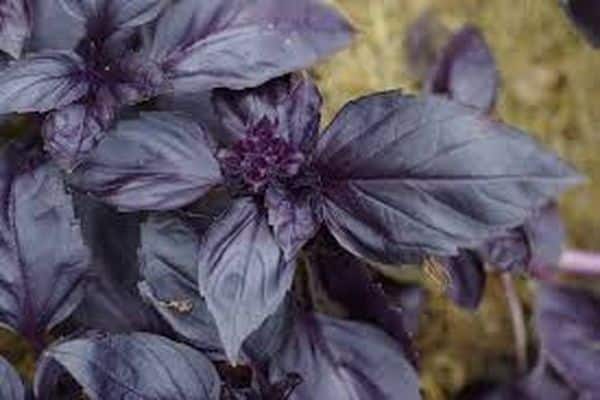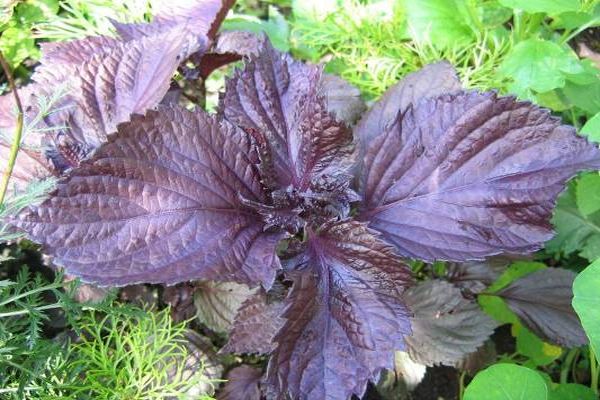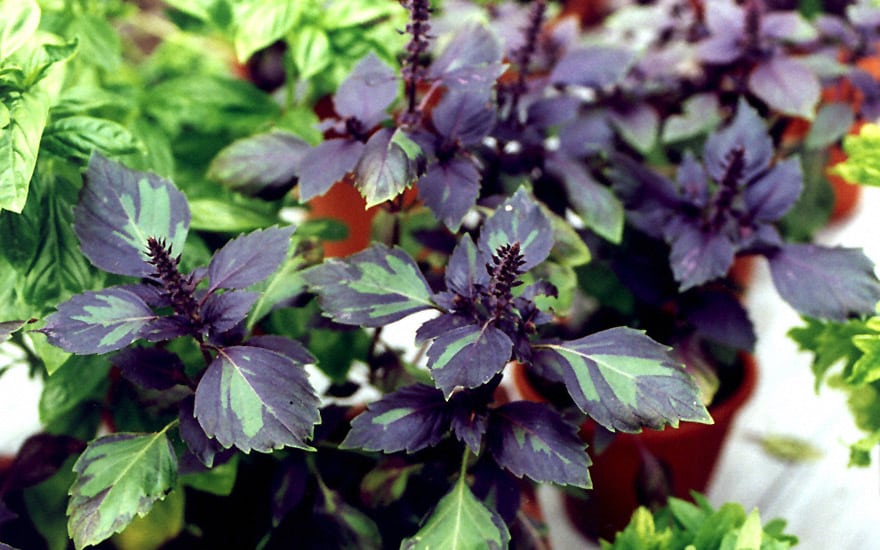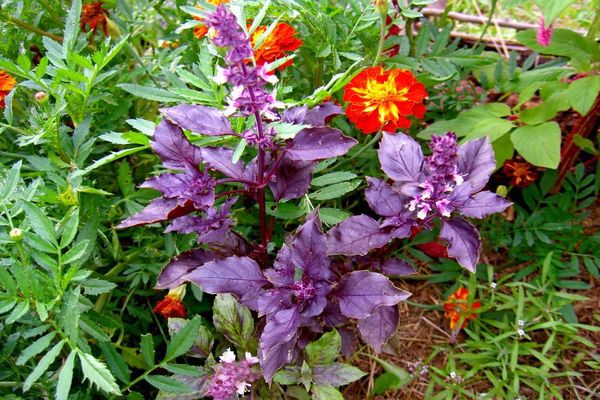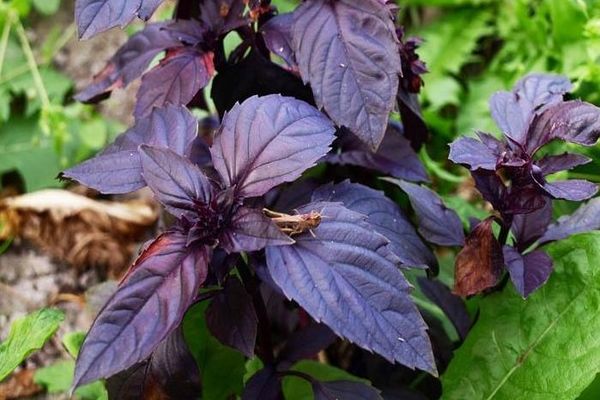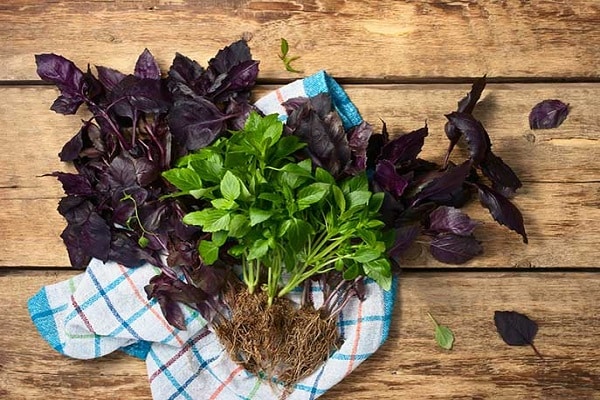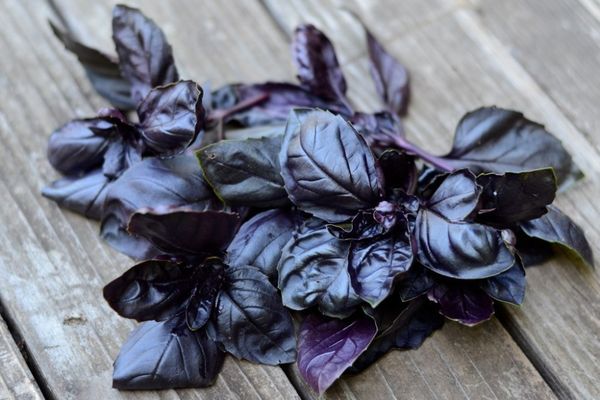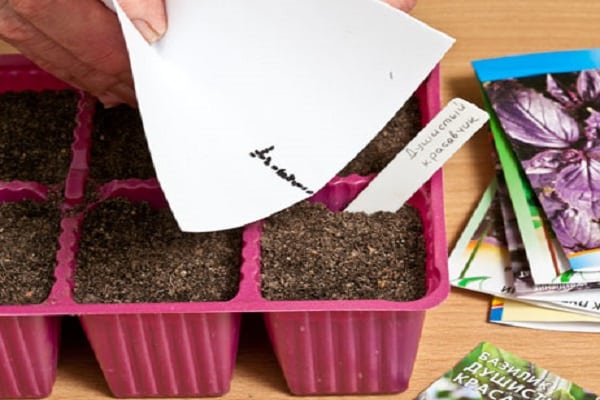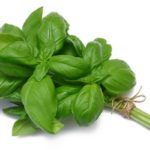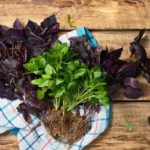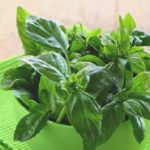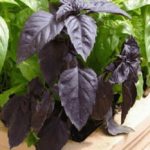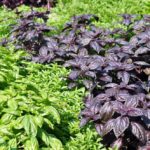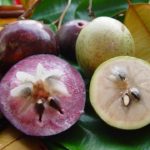Purple basil is considered a common annual plant that is simply sometimes added to food. However, in fact, this culture is unique and is popular not only among culinary specialists, but also among scientists. Due to the beneficial properties of purple basil, the plant is often used in medicine to prepare medicines to treat various diseases.
Description
Basil belongs to the family of Lamiaceae, which many people use to make seasonings. Since ancient times, residents of the Middle East and India have used this herb to create aromatic spices.
In Europe, basil did not immediately gain popularity, but only several centuries later. Over time, red basil became the favorite spice of French gourmets.
Already in the second half of the sixteenth century, this aromatic plant was used as a seasoning for fish or meat dishes throughout the world.
This annual herbal plant is native to South Asia, as this is where the most favorable conditions for its cultivation are found. However, today this spice is grown in all countries. When optimal conditions for growing basil are created, the plant grows to 70–80 cm in height. Ripe bushes are covered with oblong and ovoid leaves, at the tips of which there are small villi and denticles.
Purple basil is very beautiful during flowering. Spikelets or brushes are formed on it, which, when flowering, acquire a purple or pinkish tint. In order for the plant to bloom well, you will have to grow it in greenhouse conditions. When grown in open ground, planted seedlings may die even with minimal frost.
The nutritional value
Before planting basil or adding it to dishes, you should familiarize yourself with the composition of this plant.
The plant contains a lot of water, carbohydrates, ash, fiber and even fat in the amount of 0.6 grams per 100 grams of greens. Special mention should be made of vitamins, which are also present in large quantities. Most greens contain vitamins that are part of group B.These include folic acid, pantothenic acid, riboflavin, thiamine, niacin and choline with pyridoxine. The plant also contains vitamin A in the form of beta-carotene and ascorbic acid. Greens contain vitamins PP, K and E in smaller quantities.
Ararat vegetable basil contains a large number of useful microelements. The plant is rich in magnesium, sodium, phosphorus, calcium and potassium. It also contains about 350 grams of selenium, zinc, manganese and iron. Many people are surprised by the calorie content of greens, since it is even higher than that of cucumbers and is about 25 kcal.
Basil is distinguished by its aroma, which appears due to the essential oils in the composition. Various varieties of greens contain from one to one and a half percent of essential oils such as saponin, ocimene, camphor and methidhavinol.
Purple basil: properties
WITH beneficial properties and contraindications of purple basil Every person who plans to use the plant in cooking or treating diseases should familiarize themselves with it.
Beneficial features
Many people are interested in the benefits of purple basil and whether it has any beneficial properties. This plant has been known for its medicinal properties for many years. Even in Rus', everyone called greens the royal herb, since it was often used by folk healers in the treatment of various diseases.
Many people knew about the benefits of purple basil for the body and therefore often used it to relieve inflammation in the genitourinary system or cleanse the body. It was also often used to get rid of diseases of the digestive system.
Due to the high content of vitamins in the plant, it is used to thicken nails, change the appearance of the skin and improve the elasticity of blood vessels. Green leaves contain many essential oils, which not only give them a pleasant smell, but also enrich them with useful microelements. Due to this, the leaves of the plant are often used to prepare medicines for women and men against flatulence.
Many people call basil an excellent radioprotector that can protect the human body from the negative effects of radiation. Also, the beneficial properties of the herb include its antimicrobial effect, thanks to which diseases of internal organs are treated and wounds on the surface of the skin are disinfected.
Doctors advise men with impaired erectile function to take medications from basil. Greens are an excellent aphrodisiac that increases potency and sexual desire in guys of any age.
The beneficial properties of red basil help people cope with severe migraines. To eliminate headaches, you will have to take a hot bath with a little basil oil added. To enhance the healing effect, it is recommended to add a little cream and a few drops of honey to the oil.
Harm of purple basil and contraindications
Before treating diseases with basil, it is recommended to familiarize yourself with its contraindications so as not to harm your health. Such a herbaceous plant does not always bring only benefits and therefore some people should not use it.
It is not recommended for pregnant girls to use basil herb medicines. Regular use of such medications may disrupt pregnancy.People who have had a stroke or heart attack will also have to stop taking medications. The use of preparations made from these greens may worsen the well-being of people with hypertension or diabetes.
If you do have to take such medications, you should not take them for more than three weeks. Such medicines contain many essential oils, which are harmful to the body if taken in large quantities.
Best Purple Basil Varieties
Many people who want grow basil at home, face problems when choosing a variety of greens. Therefore, it is recommended to familiarize yourself with the best varieties of purple basil in advance.
Red ruby
The variety is a variety of red basil that is often grown by gardeners. The peculiarities of Red ruby include the size of the bushes, which are distinguished by their compactness. An adult plant is covered with dark purple leaves. ripe Basil is used fresh or frozen.
Opal
Opal bushes are covered with crimson flowers and leaves with a purple tint. When growing, it is recommended to carefully cut off all the flowers from each plant so that they do not interfere with the growth of the leaves. The leaves of this variety are used as additives for marinades, sauces, gravies and vegetable salads. In one season, about 2–3 kilograms of basil leaves are harvested from a square meter of garden.
Dark opal
Gardeners consider this particular variety to be one of the best among other varieties of purple basil. Dark opal leaves are rich in carotene, phytoncide, vitamins and essential oils. They are quite large in size and have a rich smell. The leaves are used to create preserves, vinegars and salads.The variety is also used for decorative purposes to decorate borders or flower beds.
Philosopher
Fans of early ripening plants should pay attention to the Philosopher basil variety, since its technical ripeness occurs 45 days after planting. The greenery is compact and grows only 35 cm in height. The leaves of ripe bushes have a clove flavor and a powerful aroma. The plant is used as a flavoring agent in canning and preparing salads.
Ararat
The bushes of purple Ararat differ from other varieties, as they grow up to 80 cm. The leaves on the bushes are purple with a greenish tint. They contain a lot of essential oils and carotene, so greens are often added to vegetable soups, salads and cheeses.
Sacred
The properties of Holy Basil are its main feature. The plant is rich in antioxidants, minerals and vitamins, which is why the variety is often used in medicine.
Yerevan
The purple Yerevan plant variety is actively used not only for preparing culinary dishes, but also for decoration. This is possible thanks to the large red leaves that cover Yerevan basil.
Purple stars
Purple star bushes are classified as mid-season plants that ripen one and a half months after planting. The bushes grow up to 45 cm and are covered with ovoid leaves, painted in a dark purple color. The variety is used as a seasoning for dishes or salads.
Black
A distinctive feature of Black Basil is its dark purple leaves with serrated edges. They have a faint cinnamon odor that appears immediately after the plant ripens.The variety is used to create marinades, preserves and fish dishes.
Growing
Growing basil bushes from seeds is considered difficult, as the plant requires constant care. Only warm areas that are constantly illuminated by sunlight are suitable for planting. Residents of the northern regions will have to use greenhouses to plant plants to protect the greens from frost.
Planting takes place in the second half of May, when the air temperature does not drop below zero degrees. At least 3-4 seeds are placed in each hole. After planting the seed, the seedlings must be constantly looked after. Proper care consists of timely feeding of shrubs and watering. Plants are also regularly treated with protective agents to protect them from pests and diseases.
Purple basil for healing
Basil bushes are often used to prepare medicinal decoctions and tinctures that can cure a person from various diseases. Before using herbs for medicinal purposes, you should familiarize yourself with the recipes for preparing medicines:
- Increased appetite. Basil medicines are often used to increase a person's appetite. To prepare the decoction, the dried herb is poured with hot water, covered with a lid and infused for about 10–15 minutes. After this, the liquid is filtered and taken a teaspoon before meals.
- Treatment of inflammation. Medicines in the form of decoctions are sometimes used to treat inflammation. When creating a decoction, four leaves of the herb are poured with boiled water and infused for 40 minutes. The drug is drunk daily three times a day.
- Treatment of otitis.To cope with otitis media, the leaves of the herb must be mixed with honey, added to boiled water and placed on a gas stove. The broth is removed from the heat after half an hour and cools to room temperature, after which a compress is made from it.
Use in cooking
The herb basil is often used in cooking to create various dishes. In dry form, the plant is used as a seasoning for dishes prepared from pepper, tomato or eggplant. Also, spicy herbs go well with parsley, dill or mint. It is better not to add basil leaves to dishes with coriander, as these plants do not combine.
Fresh leaves are used to make salads with any vegetables. Basil goes especially well with tomatoes, which is why many people add it to tomato sauce or ketchup.
Conclusion
Purple basil is grown in vegetable gardens or greenhouses by many vegetable growers. Before growing such greens, it is recommended to familiarize yourself with the features of its use and cultivation at home.

